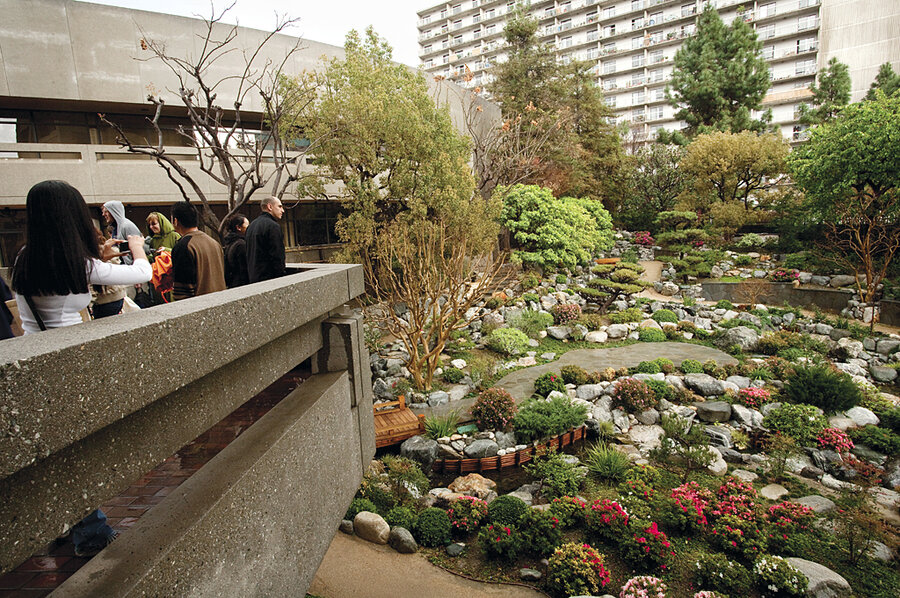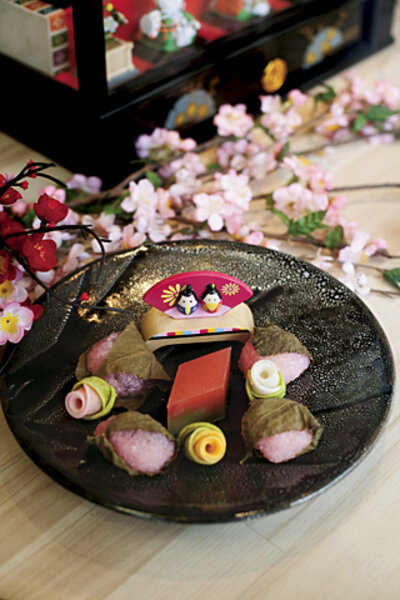Little Tokyo, Los Angeles: Getting the flavor of the place
Loading...
| Little Tokyo, Los Angeles
The fortune cookie was invented by a 19th-century Japanese immigrant, chopsticks stuck upright in a ball of rice are considered a death omen, and it's possible – though not recommended – to eat 231 gyozas (dumplings) in 10 minutes as Joey Chestnut did during last summer's annual Nisei Week.
Those are just a few of the morsels of information served up on one of the food and walking tours run by Six Taste Food Tours in Los Angeles. The 3-1/2-hour excursions offer foodies a window on both the cuisine and cultural life of various ethnic neighborhoods that many rarely explore.
"We wanted to show people a more interesting narrative sitting right inside their own city," says Jeff Okita, a fourth-generation Japanese-American who started the company last year.
The food entices the gastronomically open-minded to come, says Mr. Okita, "but we choose the restaurants based on their story and what they add to the understanding of a neighborhood, its people and its history."
We begin our tour of Little Tokyo huddled inside a reproduction of a Kyoto temple, located in front of the Japanese American National Museum. Our guide, Betsy Matz, a self-professed lover of all things Japanese, passes around a platter of Japanese pastries from the famed Yamazaki Bakery nearby. We nibble melon pan (a sweet flour pastry) and green tea mochi, made with glutinous rice.
Ms. Matz regales the group of 15 with examples of the differences between Japanese and Western pastries. "We in the West are obsessed with sugar," she says. In contrast, many traditional Japanese confections are sweetened with red bean paste.
Fortified, we head for the Japanese American Cultural & Community Center in Honda Plaza. The well-tended gardens – replete with elegant curving bridges and carefully designed waterfalls – are a favorite site for weddings.
We will make seven stops, our fast-talking guide tells us – "four sweet ones, three savory." By journey's end, we will: learn proper chopstick mechanics (hold the bottom one stationary, articulate with the top), discuss the fine points of sushi bar service (don't ask for more wasabi paste, says Matz, as this suggests the chef doesn't know his craft), and nibble mochi (this is basically pounded, very sticky rice, she explains) everywhere.
We will also learn about Little Tokyo's population shifts as a result of US policy toward Japanese-Americans in World War II.
Matz points out the 2nd Street Jazz club as we stroll. "Before the war," she says, "this area had 30,000 Japanese-Americans." So many were sent to internment camps that a mere 1,000 remained after the war. The area was resettled during that time by African-Americans, who founded the jazz club in 1942. "They saved the neighborhood from going downhill," she adds, "so the club is a local landmark."
Moving on to Wakasaya restaurant, a "savory" stop, we see the "wall of shame" – photos of customers who took the restaurant's challenge to consume a giant bowl of fish roe, salmon, tuna, sea urchin, squid, and 15 toppings within a quarter-hour. ("Finish in under 15 minutes and it's free. Otherwise: $44.80," say signs.) We eat bowls of donburi (rice with other foods on top) and sniff bottles of wasabi so strong that even the wasabi lovers among us say, "I'll pass."
In the heart of the historic district, Brian Kito, whose grandfather is credited with creating the fortune cookie, still works the counter in Fugetsu-Do, the shop his family opened in 1903.
Today, he's proud to serve mochi to the grandchildren of many people his ancestors once served. "My parents were in the internment camps," he says, "and when they came back, this area was struggling, but we are working to preserve the contributions and sacrifices of those who came before us."
Outside the shop, a black and brass timeline embedded in the sidewalk reminds us of the area's difficult history in the words of those who lived it. "1941 FBI raids Issei associations for evidence of disloyalty," reads one inscription.
"It's like the sad version of the Hollywood Boulevard walk of stars," says Matz, pointing to the collection of stories stretching through the sidewalks of the district.
We finish the tour at the incongruously named "Chop Suey" restaurant, sinking our teeth into spicy chicken wings and learning about the history of the California sushi roll. What is now a Chinese restaurant catering to the downtown business crowd used to be the Far East Café, a place of refuge and community for displaced Japanese-Americans after internment.
We enter through a narrow alleyway in the rear, which, Matz points out, "was where the old restaurant used to stash the livestock." Back then, she adds, this place was renowned for its fresh meat, "and they did that literally by penning them until they were on the menu, then someone would grab them, slaughter the [animal], and serve it right away."
The members of our tour seem content with the $55 afternoon of cultural cuisine. "It's funny how close you can live to something in L.A. and know nothing about it," says Liz Kim, who lives in Los Feliz, a neighborhood not far from downtown.
"This was a great way to get more comfortable with a part of the city I didn't know well," says Alexis Boozer.
Six Taste Tours hosts similar visits to other neighborhoods: Chinatown, the financial district, Thai Town, and a Taste of Taiwan just outside downtown in Arcadia. Also offered is a contemporary look at Little Tokyo (we took the traditional tour).
Six Taste faces language and tradition challenges in organizing the events, says Mr. Kito, the first restaurateur to work with Okita. "Occasionally, the more traditional owners don't want to change the way they do things to accommodate large groups."
But, he adds, Okita is making a valuable contribution to cultural understanding: "The tours are well done, well researched, and are helping to show people areas of the city they knew nothing about."
• Staff writer Daniel B. Wood contributed to this report.
---
Related stories:
Discover good food in Buenos Aires
Macarons conquer Paris, now London
Pungent pleasure: fish sauce secrets in Vietnam
Indian Food: Vada Pav, Mumbai's chutney-slathered vegetarian food







